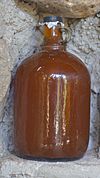Bahalina facts for kids

Commercial bottled bahalina
|
|
| Type | Palm wine |
|---|---|
| Country of origin | Philippines |
| Region of origin | Visayas, Mindanao |
| Alcohol by volume | 10%-13% |
| Ingredients | Coconut or nipa palm sap, mangrove bark extracts |
Bahalina is a special traditional drink from the Philippines. People sometimes call it "coconut red wine." It's made from the sap (juice) of coconut or nipa palm trees that has been fermented. It starts as another drink called tubâ (palm toddy), which is then aged for a long time, from a few months to several years. You can find it mostly in the southern Philippines, especially on the islands of Visayas and Mindanao. Bahalina has a deep brown-orange color and a slightly bitter taste.
What Makes Bahalina Special?
Bahalina gets its special deep brown-orange color from something called barok. Barok is made from the dried bark of certain mangrove trees. These extracts also help keep bahalina from turning sour. They also add a slightly bitter taste to the drink.
Bahalina is different from another Filipino drink called lambanog. Lambanog is made by distilling the palm sap, and it doesn't use barok. That's why lambanog is usually milky-white or clear. Bahalina has about 10% to 13% alcohol content. This is more than tubâ (which has 2%-4%), but less than lambanog (which has 40%-45%).
How Bahalina Is Made
Making bahalina starts with collecting sap to make tubâ. This sap comes from the flower stalks of coconut or nipa palm trees. The sap is collected in bamboo tubes left on the coconut tree. It usually ferments a little in these tubes for about a week.
The people who collect the sap are called mananguete or manananggot. They carefully seal the collected sap in glass jugs or large bottles. They make sure no air gets inside. The barok (mangrove bark extract) is added either in the bamboo tubes or when the sap is moved to the jugs.
After a day to a few weeks, the tubâ turns into a mildly alcoholic drink called bahal. Bahal has a sour-sweet taste and can be enjoyed as it is.
To make bahalina, the bahal is filtered through a cloth. This removes any bits that have settled at the bottom. This filtering is done daily for three months. This step is very important to stop the bahalina from turning into coconut vinegar. After this long filtering process, the jug is buried underground or stored in cool cellars. It stays there for at least two more months before it's ready to drink.
Bahalina in Filipino Culture
Making bahalina in the traditional way is very common in the Visayas and Mindanao regions. Some people call it a "poor man's drink." This isn't because it's not good, but because it's usually cheaper than other store-bought drinks.
Many people prefer bahalina that has been aged for three to five years. This longer aging makes the taste smoother. Bahalina tastes different from tubâ or bahal. Instead of being sour-sweet, bahalina is slightly bitter and tangy. People often mix bahalina with carbonated soft drinks. This makes it sweeter and gives it a taste similar to red wine.
Bahalina, along with tubâ and bahal, is celebrated every year. This happens in the Eastern Visayas region at a special event called "Oktubafest." It's a wine-tasting event that honors these traditional Filipino drinks.

